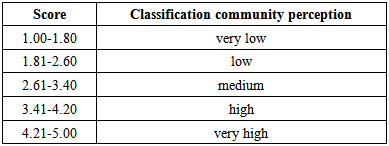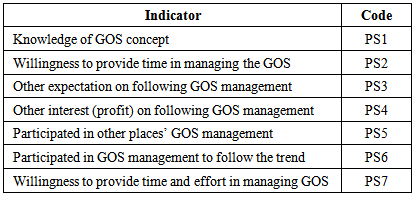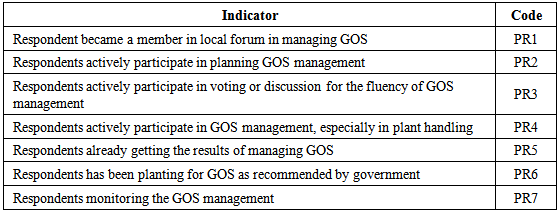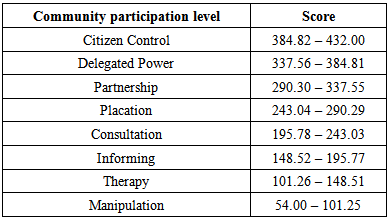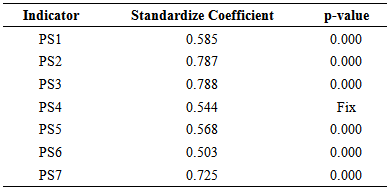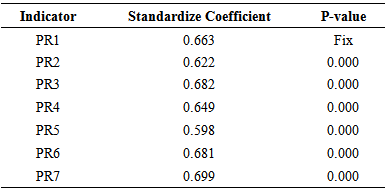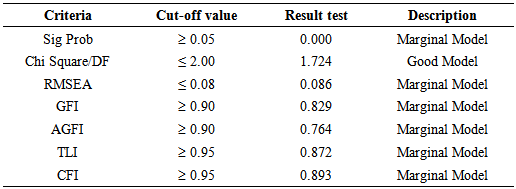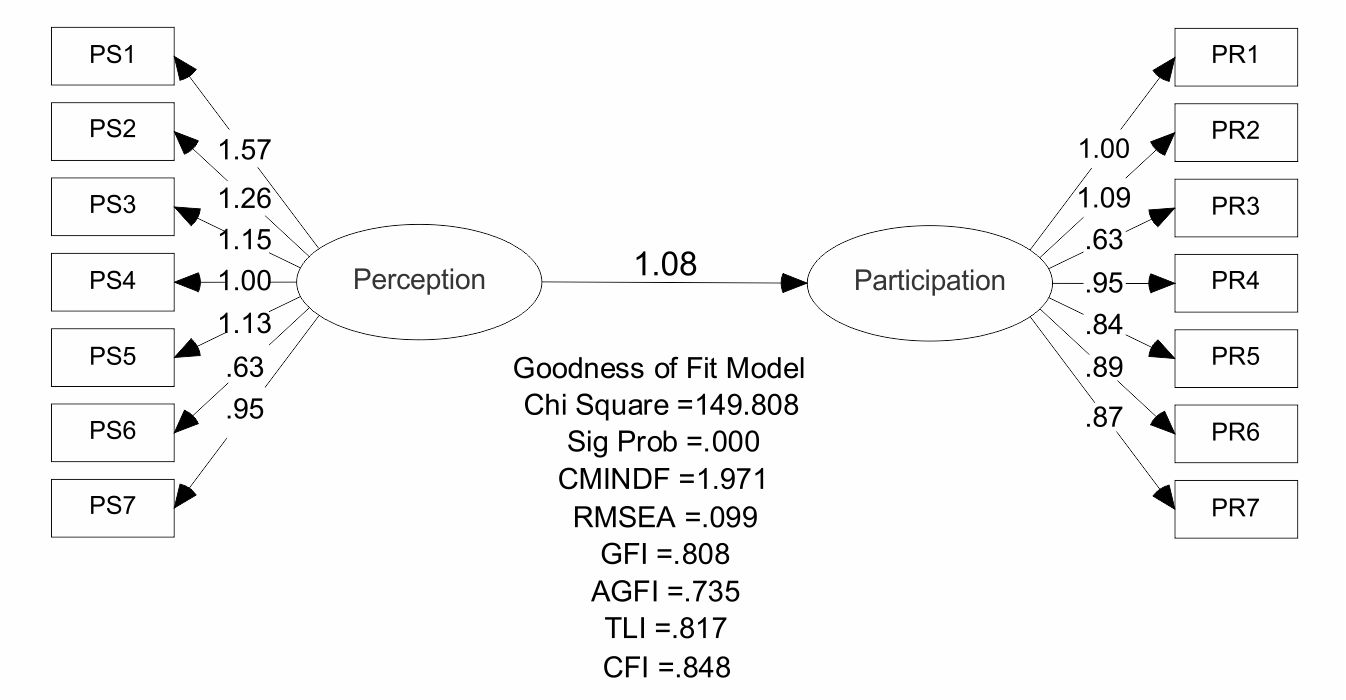-
Paper Information
- Paper Submission
-
Journal Information
- About This Journal
- Editorial Board
- Current Issue
- Archive
- Author Guidelines
- Contact Us
International Journal of Applied Sociology
p-ISSN: 2169-9704 e-ISSN: 2169-9739
2014; 4(4): 108-113
doi:10.5923/j.ijas.20140404.03
Perception and Participation on Co-Management of Green Open Space in Coastal Reclamation Area Manado
Sonny Wantouw1, Antariksa2, Bagyo Yanuwiadi3, Zetly Tamod4
1Doctoral Program of Environment Science and Technology, University of Brawijaya
2Department of Architecture Engineering, Faculty of Engineering, University of Brawijaya
3Department of Biology, Faculty of Mathematic and Natural Science, University of Brawijaya
4Department of Soil Sciences, Faculty of Agriculture, University of Sam Ratulangi
Correspondence to: Sonny Wantouw, Doctoral Program of Environment Science and Technology, University of Brawijaya.
| Email: |  |
Copyright © 2014 Scientific & Academic Publishing. All Rights Reserved.
Reclamation on coastal area in Manado were functionally developed into Central Business Distric (CBD) BAM. The reclamation changed the coastal area includes reduce the accessibility to Green Open Space (GOS), decrease the sustainable GOS function, restrict the flexibility access of community to GOS and enclosed the GOS into private-domain public area. It lead to the disconnection of social interaction. This research was aimed to assess the correlation of community perception and participation toward activity of GOS in coastal reclamation area Manado. We used proportional random sampling by questionnaire. Total of a hundred respondents represent the government, businessman, and community in the converted land area. The results showed that there are influence of public perception and participation on shared management of GOS in the reclamation area. The higher public perception resulting higher public participation.
Keywords: Community Participation, Community Perception, Green Open Space, Reclamation Area, Structural Equation Modelling
Cite this paper: Sonny Wantouw, Antariksa, Bagyo Yanuwiadi, Zetly Tamod, Perception and Participation on Co-Management of Green Open Space in Coastal Reclamation Area Manado, International Journal of Applied Sociology, Vol. 4 No. 4, 2014, pp. 108-113. doi: 10.5923/j.ijas.20140404.03.
Article Outline
1. Introduction
- One of important things in urban area is public open space which physically changed according to the community development. Public open space is accessed freely and applicable to everyone for their community activity. Public open space shaped as path (green line, lake’s edge, riverbanks, railroad, and networks of electrical voltage) and city nodes (home garden, neighborhood and city parks, cemetery, etc) [1]. Public open spaces contribute in improving the quality of life and offer a healthier life for the community by providing the opportunities for physical and recreational activities. In other words, public open space enhances physical and psychological community welfare as well as facilitating the social integration of the user [2].Generally, Green Open Space (GOS) is part of public open spaces in urban areas which filled by plants, crops and vegetation (endemic or introduced) [3]. The provision of this area is beneficial in the ecological, psychological, social-cultural and architectural aspects that provide economic benefits and human welfare [4]. Green open space offer the opportunity to build social interaction and contribute in enhancing the sense of place, thus increase the community's identity, solidarity, security and improve community comfort [5, 6].Based on the structure, form and composition of GOS is an ecological landscape configuration, e.g. protected area, mountains, river, lake and coastal area [3]. Green open spaces in coastal area are useful to improve the water quality, prevent the flood, protect coastal area from abrasion, reduce the air pollutant, prevent the tsunami and reduce the air temperature. Manado as a city in Indonesia located at coastal area. The city developed the center of human activities, both recreation or earns living. All of these activities influence the existing public space in coastal area; where the development of reclamation area indicate the lost of public space [7]. The reclamation of coastal area in Manado lead to the risk of abrasion, change the shorelines and threaten the safety of the community settlement. The reclamation also reduce the accessibility to GOS, decrease the sustainable GOS function, restrict the flexibility access to GOS and enclosed the GOS into private-domain public area. It also implied on the degradation of GOS social function as an area in forming the social interaction. This activity is the main requirement for the occurrence of social activity and social reality. Generally, the social reality is based on individual motivation and its social actions [8]. Therefore, we assessed the correlation of GOS activity in coastal area of Manado towards community perception and participation in this reclamation area.
2. Research Method
2.1. Study Site
- This studies conducted in four District within the center of Manado, i.e. Wenang, Sario, Malayang and Tuminting. Manado is located in North Sulawesi, with total area of 157.26 km2 (Fig. 1).
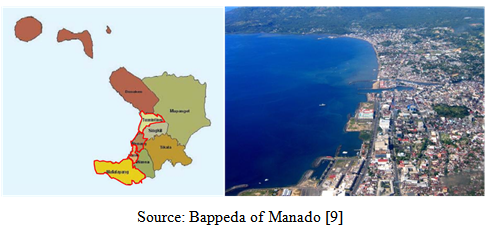 | Figure 1. Research Site of Manado Coastal Area |
2.2. Data Collection
- Quantitative data sample was selected by proportional random sampling method using questionnaire. The sample size was adjusted to Structural Equation Modeling (SEM) [10]. This study used 100 respondents consisting of representatives from government, businessman and land conversion affected community.
2.3. Data Analysis
- Data were analyzed descriptively by providing an overview and interpreting the tabulated primary data. The aim of this analysis was to obtain a description of each studied variables, e.g. level of perception and participation community on GOS co-management, the characteristics of frequencies and percentages of each variables, and general overview on the research object. Interpretation criteria for measuring the public perception were classified into five levels (Table 1).
|
|
|
|
3. Result and Discussion
3.1. Community Perception on GOS Co-Management
- Level of community perception on GOS co-management in Manado reclamation area measured from seven indicators (Fig 2). Indicator with the highest average score was willingness to provide time for managing the GOS (PS2). Perception about GOS management was able to provide a positive impact for community surround reclamation area in Manado. These results were similar to Peters et al. [6] which reported public perception is not only stimulated by intense, formal and structured interaction among familiar person or group, but it also could be started from informal and casual interaction, e.g. brief chat. Through social inter-action, people feel greeted, connected with others and at the same time feel comfort. The main factors that establish the public perception about GOS is inclusive and accessible public open space to all community from various ethnic and socio-economic statuses.
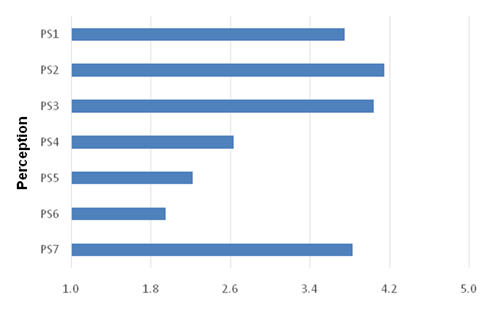 | Figure 2. Community perception indicators on GOS Co-management |
3.2. Public Participation on GOS Co-Management
3.2.1. Indicators on Community Participation
- The level of community participation also used seven indicators on GOS co-management in Manado coastal reclamation area (Fig. 3). The third indicator (PR3) has highest average score than other indicators. It means that Manado community already aware about the importance of participation on GOS management in Manado reclamation area. This awareness is encouraging community to be actively providing any advice, input and suggestion during discussion to create fluent implementation of GOS co-management.
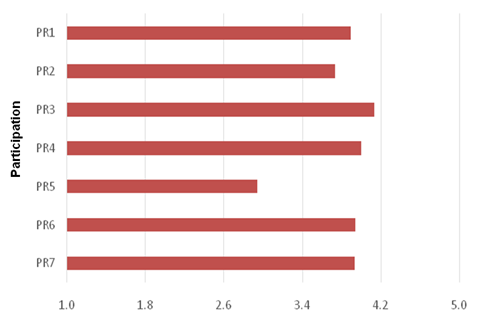 | Figure 3. Community participation indicators on GOS Co-management |
3.2.2. Typology of Community Participation
- The score level of community participation on GOS co-management in Manado reclamation area was 379. Thus, participation level of Manado community was included in Delegated Power category. It implies that government has been encouraging Manado community to actively participate in managing the GOS in Manado reclamation area. This study showed that Manado community was optimally participating in GOS management program in reclamation area and absolutely incorporates in programs’ planning and implementation. At this level, government gave authority to communities in providing dominant decision on a particular plan or program. The government should negotiate with the community and avoid any pressures in solving the problems within the management. However, the authority to make decisions and approved plans were legitimated by the government [20, 21].Folke et al. [22] explained that the participation of politicians and governmental administrators seems to increase the integration of conservation and development; producing gratify outcomes. Similar to governmental participation, stakeholder holds crucial role in maintaining the co-management. Sandström and Windmark [23] also found that co-management system in which the uneven power between stakeholders would be unsustainable. However, it is unclear how the consequences of the disparity might have for the viability and stability of the management system. It is proposed to use the consultation procedures as tools for co-managing, as conducted in the management of forest resources in Northern Sweden.
3.3. Correlation of Perception and Participation
3.3.1. Assumed Test of Structural Model
- Linearity assumed by Curve Fit Test in SPSS software. We used parsimony principle, where the model considered linear if all of the model have significant or non-significant score. The variables of perception and participation in this study were assumed to have a linier correlation (Appendix 1) in the GOS co-management.
3.3.2. Model Suitability
- Suitability evaluation of correlation model on perception and participation in this study were presented in path diagram. Results tests of Overall Goodness of Fit showed that CMIN/DF classified as recommended good model. Criteria of good model implies from the value of Chi Square/DF of ≤ 2.00. In this study, the value CMIN / DF has fulfilled cut-off value (Appendix 2). Therefore, the proposed SEM models in this research (Appendix 3) is suitable and feasible, thus possible to be interpreted for a further discussion.
3.4. Measurement Model of Perception and Participation
3.4.1. SEM Analysis
- The SEM analysis showed that the third indicator (PS3) has the highest value of Standardize Coefficient (Table 5). This indicator informs that community has other expectations or interests for participation of GOS co-management.
|
|
3.4.2. Structural Model
- Structural model measuring direct influence or correlations between community perceptions and partici-pation on GOS co-management. The positive structural model coefficient (0.731) indicates that community perception and participation had positive influence or uni-directional (Table 7). It implies the higher community perception (PS) resulting a higher community participation (PR) level and in reverse.This result supported Taylor [24] opinion on a person's perception on an object could be true or false. In this study, the object of GOS co-management in Manado reclamation area was not be directly perceived by the community. Community tends to wait for stimulus from socialization or training on this management program. Although these activities bring benefits to community, they felt to be forced (not their own willing). Whereas, a program will correctly runs if it is carried out voluntarily by community, without coercion [25]. Although most of them follow these activities, especially supported by the wages, then they are forced to participate in the management activity.
|
4. Conclusions
- Community perceived the GOS co-management in Manado reclamation area positively and lead to high participation level on the managemnet. Manado communi-ties aware the importance of participation in GOS co-management, thus they actively provide suggestion during management. Community perception is positive linear related to the participation in GOS co-management. Public perception and participation influence on the shared management of GOS in the reclamation area. The higher public perception resulting higher public participation.
 Abstract
Abstract Reference
Reference Full-Text PDF
Full-Text PDF Full-text HTML
Full-text HTML